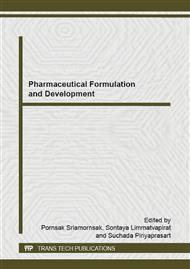p.203
p.207
p.211
p.215
p.219
p.223
p.227
p.231
p.235
Validated UV-VIS Spectrophotometric Method and Stability Assessment of Extemporaneously Prepared Ceftazidime Ophthalmic Solution for Hospital Use
Abstract:
A simple, rapid and cost effective UV-VIS spectrophotometric method was validated and applied for stability assessment of 5% ceftazidime in extemporaneous ophthalmic solution in various conditions. Ceftazidime dissolving in sterile water showed the maximum absorbance (λmax) at 256 nm and no interference was observed. The method validation was determined in term of linearity, intra-day and inter-day precision, accuracy, limit of detection (LOD) and limit of quantitation (LOQ) according to ICH guideline. Spectrophotometric response was linear with r2 = 0.9998 in the range of 5-25 μg/mL. The mean recovery was 99.38% with percent relative standard deviations (%RSDs) of 0.83. Intra-day and inter-day precision showed %RSDs of < 1.00%. LOD and LOQ were 2.60 and 7.88 μg/mL, respectively. The method was reliable for stability study of extemporaneous ceftazidime ophthalmic solution. Results showed that the amount of ceftazidime in extemporaneous formulation stored in both ambient and accelerated conditions dramatically decreased within 1 day. However, the preparation was stable at 2-8 °C for 7 days. In conclusion, the storage temperature had greatly impact on ceftazidime ophthalmic solution therefore it should be kept in the refrigerator for a week and its stability could be monitored using the simple spectrophotometric method.
Info:
Periodical:
Pages:
235-239
Citation:
Online since:
December 2014
Keywords:
Price:
Сopyright:
© 2015 Trans Tech Publications Ltd. All Rights Reserved
Share:
Citation:


